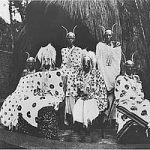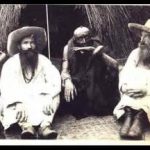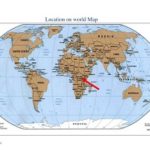RELIGION
Generally speaking, the religion of the Banyaremera consists of ancestor worship. Sacrifices are made to the ancestors, but in a very sporadic fashion and by only a few individuals. These people have usually been driven to it after having tried everything else to — let us say, cure a sick child; they finally went to a diviner who told them that the sickness is due to the demands of a specific deceased ancestor, who could be either male or female.
Very few Banyaremera show real conviction, not only in their belief in diviners, but even in their belief in an after-life. Monsieur Georges Sandrart quotes a well-known Kinyarwanda proverb, which, translated, reads: “He who has been eaten by Death has never returned to tell what he saw in Her stomach.” Only a very few persons have any amararoy’abazimuin their rugo. These are little huts built for the spirits of the ancestors. In the not too distant past, there had been ceremonies of initiation (kwaturaand kubandwa) into the religion of ancestor worship. These seem to have fallen into desuetude, however, or, if anyoccurred during the period of this investigations, the researcher was unaware of them.
In private conversation, some missionaries express the opinion that the Banyarwanda are rather indifferent to matters of religion, whether these concern the ancestor cult or Christianity.
An attitude of indifference also surrounds rainmakers. It seems that, even in the days when there still were famines, people never did put much trust in them, but they might eventually call in a rainmaker, out of desperation, when everything else had been tried. If it did not rain, the rainmaker would be put to death, if he did not escape first. In Remera it seems one had been called in some years past by men now in their forties.
In making the above remarks, considerable caution is exercised because this researcher is aware that, under trying circumstances, a religion can become a nativistic movement and be driven underground. Also, nothing can drive native supernatural practices underground as effectively as mission activity. It is certain that some information was lost because of this. However, if is highly improbable that, during the year of investigation, no hint of the existence of such a movement would have appeared, if one had existed. Moreover, the answers to queries on religion, although not systematically posed, are consistent, and, finally, the attitude of the Banyaremera towards all natural phenomena tends to confirm this indifference: there is no attempt made by them to explain natural phenomena. The standard answer is that “rain is rain and thunder is thunder.” It is only when pressed that they might sometimes give an answer that could be classified as folklore.
The attitude towards “doctors” (usually specialists in cupping and herbs, abarumitsi), and diviners (abapfumu), is not much different; but they are, in fact, consulted more often than the rainmakers are. There is one umupfumu on Remera, who covers a large territory in his “practice” — from the mines of Rwinkwavu, south to Burundi, where he had originally lived. People go to him when all else, including the European doctor, failed. He is paid in goats, parts of beef, cash, produce, and even labor. However, as far as the people of Remera are concerned, the most popularumupfumu is a little old woman, whom one consults regarding the significance of dreams, or for common advice. Her assistance is inexpensive, but she has “work” enough to be able to keep her-self supplied with goats that she uses for meat.
There is, however, among the Banyaremera, always a great concern about the powers of witches (abarozi). Death and sickness are usually attributed to “poisoning” this latter word being understood in a very broad sense. Those reputed to be witches are said to be able to curse someone by afflicting him with disease or death. These witches most often deny they are witches. However, there may have been some who became “professional” witches but these might best be called shamans, as they use the paraphernalia of their station quite deliberately, although the same native term is used to designate these practitioners. Witches, generally speaking, feel quite innocent and their status rests in the minds of their accusers.
Shortly after the advent of the Europeans, another cult seems to have spread to Gisaka from Ndorwa, to the north. It is strange, but perhaps significant in the history of a state in the process of consolidation, that similar cults sprang up under different names in different parts of Ruanda. In Gisaka, the cult is known as Nyabingi; in Central Ruanda, it is Ryangombe; and in Migongo, it is Nyaburezi.
Nyabingi is a centralization, so to speak, of the cult of ancestors. It is a kind of platonic ideal of “ancestor”, rather than the particular spirit of a particular ancestor. Nyabingi is female, however, as opposed to Ryangombe who is male. It is to be noted that three out of four instances of sacrifice to ancestral spirits recorded in Remera were made to female ancestors.
It must be recognized, however, that the cult is rather secretive. At least one Remera informant, a member of the cult, would seek favor from Nyabingi by going some twenty to twenty-five miles away to a priest more famous than the priestess at Remera.
The authorities, particularly in Uganda, considered the sect as subversive, and pursued its members and priests. At one time, the administration and the missions considered that Muhumuza, the Queen mother of a deposed Mwami, used the sect to further her political aspirations. However, today it seems to have lost all political importance and significance.
If any rituals of a religions character have been connected with cattle on Remera, there are no traces of them left. Only a few individual superstitions exist which have nothing to do with any religious system.
https://uk.amateka.net/religion/https://uk.amateka.net/wp-content/uploads/2021/05/foyer-charite-remera-ruhondo.jpghttps://uk.amateka.net/wp-content/uploads/2021/05/foyer-charite-remera-ruhondo-150x150.jpgModel CitizenshipGenerally speaking, the religion of the Banyaremera consists of ancestor worship. Sacrifices are made to the ancestors, but in a very sporadic fashion and by only a few individuals. These people have usually been driven to it after having tried everything else to — let us say, cure a...BarataBarata rpierre@ikaze.netAdministratorAMATEKA | HISTORY OF RWANDA




